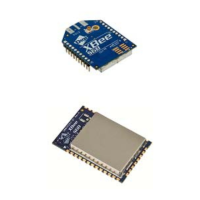© 2014 Digi International Inc. 24
XBee/XBee-PRO
®
DigiMesh 2.4 User Manual
AT Command Mode
To Enter AT Command Mode:
Send the 3-character command sequence “+++” and observe guard times before and after the
command characters. Refer to the “Default AT Command Mode Sequence” below.
Default AT Command Mode Sequence (for transition to Command Mode):
• Do not send characters for one second [GT (Guard Times) parameter = 0x3E8]
• Input three plus characters (“+++”) within one second [CC (Command Sequence Character)
parameter = 0x2B.]
• Do not send characters for one second [GT (Guard Times) parameter = 0x3E8]
Once the AT command mode sequence has been issued, the module sends an “OK\r” out the
DOUT pin. The “OK\r” characters can be delayed if the module has not finished transmitting
received serial data.
When command mode has been entered, the command mode timer is started (CT command),
and the module is able to receive AT commands on the DIN pin.
All of the parameter values in the sequence can be modified to reflect user preferences.
Note: Failure to enter AT Command Mode is most commonly due to baud rate mismatch.
When using XCTU, ensure that the ‘Baud’ setting on the “PC Settings” tab matches the
interface data rate of the RF module. By default, the BD parameter = 3 (9600 bps).
To Send AT Commands:
Send AT commands and parameters using the syntax shown below.
Syntax for sending AT Commands
Note: To read a parameter value stored in the RF module’s register, omit the parameter
field.
The preceding example would change the RF module Destination Address (Low) to “0x1F”. To
store the new value to non-volatile (long term) memory, subsequently send the WR (Write)
command.
For modified parameter values to persist in the module’s registry after a reset, changes must be
saved to non-volatile memory using the WR (Write) Command. Otherwise, parameters are
restored to previously saved values after the module is reset.
Command Response
When a command is sent to the module, the module will parse and execute the command. Upon
successful execution of a command, the module returns an “OK” message. If execution of a com-
mand results in an error, the module returns an “ERROR” message.

